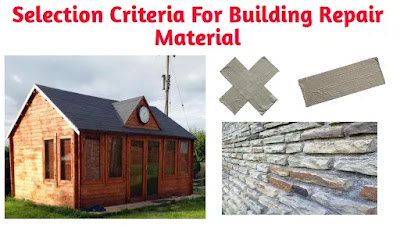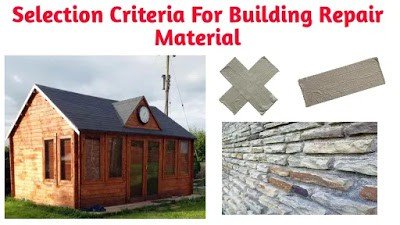In this article we discuss how to select repair material for building maintenance, all factors like cost, aesthetic, workability, durability, coefficient of thermal expansion, shrinkage properties, etc.
So please read the article till the end, and if you find any useful information than please share with your friends.
Table of Contents
How to Select of Repair Materials For Building Defects Maintenance
Selection of Building repair materials is an important and complex process. It is important to understand the needs of the owner, engineer, and Architect. The final choice of the Repair material is made on the basis of the relationship between cost, performance, and risk.

The following factors should be considered when choosing a Repair material:
- Low shrinkage properties
- Good hardening / setting properties
- Good workability
- Good bond strength with existing substrate
- Compatible coefficient of thermal expansion
- Compatible mechanical properties and strength to that of the substrate
- Low air and water permeability
- Alkaline character.
- Durability, non – degradable
- Minimal or no curing
- Should allow relative movement, if expected
- Cost
- Non – polluting / non – hazardous
- Good aesthetics
Also Read: What is Corrosion of Reinforcement
1. Low shrinkage properties
Cementitious materials shrink overtime and their bonding decreases. Shrinkage cracks develop due to Strain and stress of the material.
Atmospheric air and water can easily enter the concrete by shrinkage and others, which is detrimental to concrete and reinforcement steel.
Therefore the less shrinkage repair material should be chosen. Necessary properties can be obtained by adding non-shrink compounds in the cement.
Low cement content and low w / c ratio also reduces drying shrinkage. Shrinkage property is totally affected on durability of repair material which is very important fo the selection of repair material.
2. Good hardening setting properties
The setting and hardening time of the repair material should be minimum due to that repaired structure can be used quickly, and reduce the downtime of machinery, buildings, or roads.
But in some cases, where more working time is required, a slow setting and hardening time property consisting repair material is desirable.
Also Read: Causes of Cracks in Concrete
3. Good workability
For effective and sustainable repair, the workability of the repair materials should be good. So that for obtaining good workability, Admixture should be added to the repair material.
If the workability of repair material is very less then the material is not easy to apply therefore workability is also affected the selection of repair material for building maintenance.
4. Good bond strength with existing Sub-Strate
The repair material, which has to be attached to the material, should produce good bond and strength. Strength can be improved in the following ways
- Use of Adhesive
- Interlocking system on surface
- Mechanical bonding, etc.
5. Compatible coefficient of Thermal expansion
The temperature expansion constant of the repair material should be compatible with the temperature expansion constant of the base material below it.
If the temperature expansion constant of both the materials is different than both materials are separated from the bond line or cracks appear in the material with low strength.
If the coefficient of thermal expansion is not similar then the defects develop in repairing work which also affects the durability of work therefor thermal expansion coefficient also affects the selection of repair material.
Coefficient of Thermal Expansions of Commonly Used Building Material
| Material | Coefficient of Thermal Expansion in 10-6/°C |
|---|---|
| Igneous rocks | 8 to 10 |
| Lime stones | 2.4 to 9 |
| Marbles | 1.4 to 11 |
| Sand & sand stones | 7 to 16 |
| Slates | 6 to 10 |
| Aluminium | 25 |
| Bronze | 17.6 |
| Copper | 17.3 |
| Lead | 29 |
| Steel and iron | 11 to 13 |
| Bricks and brickwork | 5 to 7 |
| Cement mortar and concrete | 10 to 14 |
| General purpose non-shrink concentitious micro-concrete | 10 to 12 |
| Polymers modified mortar/concrete | 10-12 |
| Epoxy mortar/concrete | 20-25 |
Also Read: Strengthening of Existing RC Slab
6. Compatible mechanical properties and strength to that of the substrate
The mechanical properties of the repair material should be consistent with the mechanical properties of its base material. The Yield Strength of Repair material should be slightly more than the Base Material Strength.
If the base material is M20 grade concrete, the repair material should not be less than the M20 grade and should not be greater than a mix of the M25.
7. Low air and water permeability
If the permeability of Repair material is high then water, chemicals, CO2, oxygen, industrial gas etc, easily enter into the structure such as RCC. These chemicals affect the reinforcement of concrete.
So that the permeability of the repair material should be very low to provide adequate protection to the reinforced concrete against ingress of harmful environmental chemicals.
8. Alkaline character
The pH value of the concrete around reinforcement is More than 11.5 so that the steel does not corrode. Repair material should not reduce the alkalinity of the base material. The alkaline factors is important for all type of repair work and the selection of repair material.
9. Durability, non-degradable
The repair material should be resistant to sulfate attack, acid attack, UV rays, infrared rays, heat, etc. during its exposure conditions.
Also Read: How to Repair Dampness
10. Minimal or no curing
The repair material should be one that requires the least amount of curing. The repair material should be well rigid and provide the required strength.
Epoxy repair material not required any type of curing. But Cement base materials usually require medium curing. Curing compound can also be installed on cemented repair materials.
11. Should allow relative movement, if expected
The repair material should be elastic for sealing cracks near expansion joints and where movement is required. It should allow relative movement without any cracks or distress.
12. Cost
The cost of the repair material affects the cost of the entire repair scheme. Don’t buy the cheapest repair material, first check the repair material is durable or not then buy any material. Cost is major factor of the selection of repair material. And it affects all type of work.
13. Non – polluting / non – hazardous
Repair material should not be harmful to artisans and should not be harmful to the environment.
14. Good aesthetics
The color and texture of the reaper material should blend in with the structure and make the structure look attractive.

